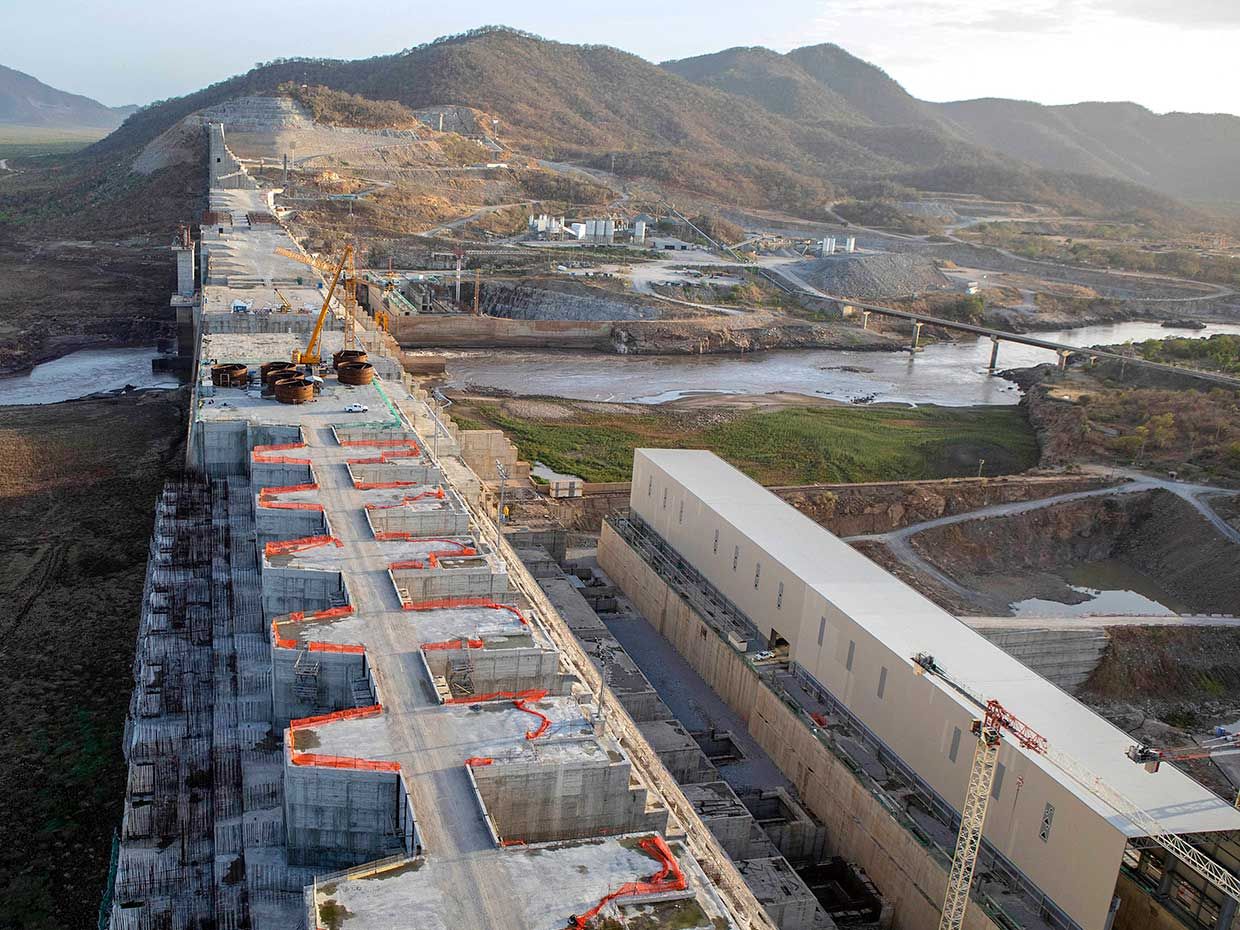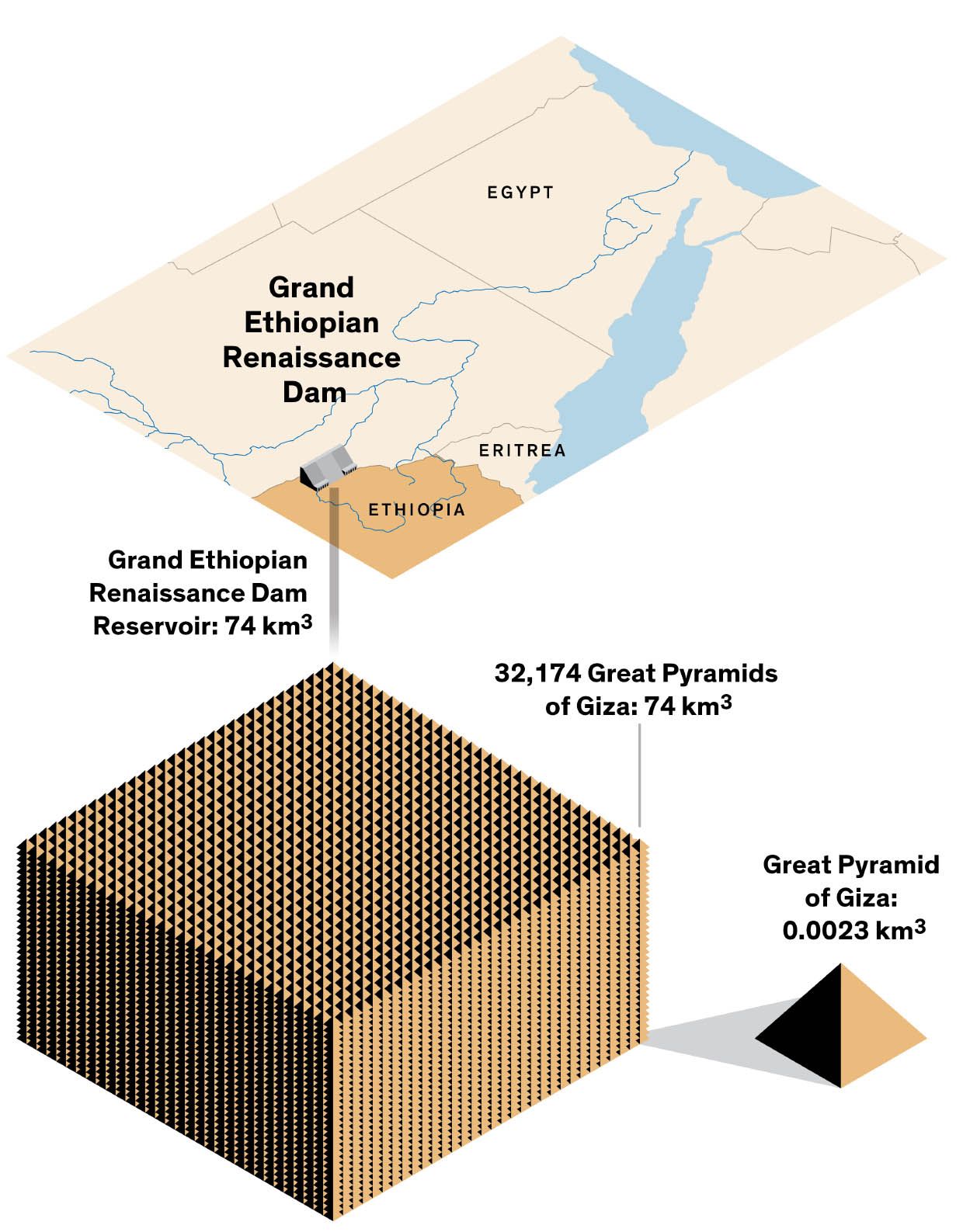Squabbling Over the Waters of the River Nile
 Photo: Zacharias Abubeker/Bloomberg/Getty Images Construction machinery stands in the center of the dam wall at the site of the Grand Ethiopian Renaissance Dam, under construction in the Benishangul-Gumuz Region of Ethiopia, on Tuesday, May 21, 2019.
Photo: Zacharias Abubeker/Bloomberg/Getty Images Construction machinery stands in the center of the dam wall at the site of the Grand Ethiopian Renaissance Dam, under construction in the Benishangul-Gumuz Region of Ethiopia, on Tuesday, May 21, 2019. The completion of the Grand Ethiopian Renaissance Dam on the Blue Nile has made Egypt fear for its very existence. To understand why requires the appreciation of basic water-flow and water-use numbers in the region.
The Blue Nile flows from Ethiopia's Lake Tana, carrying 48.3 cubic kilometers of water a year. In Khartoum, Sudan, it merges with the White Nile, which adds 26 km3/year. The Atbara adds 11.1 km3. These rivers, coming out of Ethiopia, together provide about 70 percent of the Nile's flow into Egypt.
The Anglo-Egyptian treaty of 1929 secured for Egypt the rights to 48 km3 of water; the 1959 treaty update raised the amount to 55.5 km3, with Sudan getting 18.5 km3. After accounting for the intervening water losses in the annually flooded Sudd swamps of South Sudan, this allocation left all the other states along the Nile tributaries with no claims to the water at all.
Egypt still upholds this allocation, but in 2009 Ethiopia began a de facto dismantling of the arrangement with the completion of a dam on the Tekeze River, a tributary to the Atbara. At 188 meters high, it is the tallest African arch dam (shaped to resist water pressure), although it has an installed hydropower capacity of just 300 megawatts and a relatively small reservoir, holding 9 km3. The next Ethiopian action, the Tana Beles hydro project (460 MW), began to generate electricity in 2010 and has no storage. Instead, it gets its water straight from Lake Tana and discharges it into the Beles River, a tributary of the Blue Nile. By themselves, these two projects would cause little worry to Egypt, were its dependence on the Nile's water not becoming precarious.
How Very DivertingEgypt drinks from the River Nile, and the country stands to lose should anything cut the flow from its tributaries, which originate deep within Africa. Just such a threat now looms following the inauguration of the Grand Ethiopian Renaissance Dam.
 Illustration: Francesco Muzi/StoryTK
Illustration: Francesco Muzi/StoryTK In 1959 Egypt's population was about 26 million, by 2020 it had nearly quadrupled to just over 100 million, and it is now increasing by a little under 2 million a year. This growth has reduced the country's per capita annual supply of fresh water to only 550 cubic meters, less than half the U.S. rate. Should the population reach its projected size of 160 million in 2050, this rate might fall below 400 cubic meters.
The challenge is greatly increased by the new Renaissance dam on the Blue Nile, near Ethiopia's border with Sudan. The dam, completed in June 2020, has an installed hydropower capacity of 6.45 gigawatts and a reservoir designed to hold 74 km3. The rainy season of 2020 has already put in 5 km3 of water.
Filling the rest of the reservoir in five years would cut the annual flow out of Ethiopia by 30 percent and thus the flow into Egypt by just over 20 percent (that is, 30 percent of 70 percent). This would deprive Egypt of one-fifth of its water, and even after the reservoir has been filled, retention of flows during dry years would continue to limit the downstream supply.
What Egypt sees as a mortal challenge, Ethiopia considers to be its inalienable right: That country numbers 115 million people, growing by 2.6 million a year, and it has a per capita gross domestic product less than 20 percent of the Egyptian average. Should Ethiopia forever remain hopelessly impoverished to support a better-off country?
Partial solutions are possible, but none is easy or easily affordable. Egypt's own Aswan High Dam (2.1 GW), completed in 1970, impounds 132 km3 but, situated in one of the world's hottest regions, it loses annually up to 15 km3 to evaporation. Storing this water in a less extreme environment (the best location would be in South Sudan) would reduce the loss but deprive Egypt of 2.1 GW of installed capacity and of water control for its deltaic irrigation. Channeling the White Nile through South Sudan, around the Sudd swamps, would cut the region's huge evaporation losses, but ever since gaining its independence in 2011, that nation has experienced endless civil war, tribal fighting, and chronic political instability.